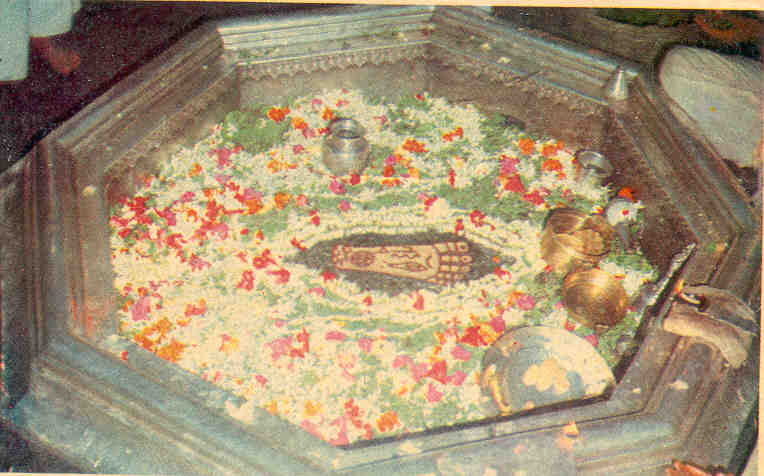Significance: This is
one of the greatest Vaishnavaite Temples and is the most sacred Pinda Daana Vedi
- (site of offerings for the ancestors) in Gaya. Vishnu’s footprint stamped on a rock
called Dharmasila is the object of worship here. The footprint lies in a
silver trough. Gaya is located in Bihar. Buddha Gaya located nearby and Gaya have been
revered pilgrimage sites since antiquity.

The other well known temples in Gaya
are the Prapitaa Maheswara Temple, the
Dakshinaarka Temple and the Mangala Gowri temple.
Antiquity:
The ritual of offering pindas or offerings to the dead has been long associated with Gaya
and has been mentioned in the epics. (Vaayupuraana). Terra-cotta seals
discovered at Vaishali dating back to the Gupta period (4th to the 5th century CE) place
the existence of this temple even during that period. This structure and the brick
structure built following its demise do not exist today. What is seen now is a relatively
modern temple, built by Queen Ahilyabai Holkar of Indore in 1783.
Architecture:
This temple faces the East and it is octagonal in plan with its tower reaching a height of
100 feet. The temple is built of gray granite blocks joined with iron clamps. The sides of
the octagons of the pyramidal tower, are alternately plain and indented - each angle while
reaching the pyramidal roof, culminating in a series of peaks, one above the other until
they all merge in a single tall pinnacle, crossed by the lotus shaped Amalaka and the
golden Kalasha.
In front of the shrine
is the spacious Sabha Mandapa - or an open pillared hall. It is a double
height space accessed by galleries all around. This hall has 42 pillars disposed in two
stories. Over the central portion is a graceful dome, 80 feet high formed by overlapping
of stones. The pillars contain various artistically executed motifs. The beautiful style
of this temple, with its impressive Sabha Mandap represents the Indian architectural glory
of a comparatively recent date.
Other shrines
in the temple: There are minor shrines dedicated to Shiva and Lakshmi adjacent to
the Sabha Mandap.
Other minor
temples in the complex: Temples of Gadhadhara (1040 CE), Narasimha, Gayeswari
(1459) are some of the ancient temples in the complex. The shrines, cells and courtyards
around the temple contain hundreds of beautiful stone images mostly belonging to the Pala
and Sena Periods. (800-1300 CE).
Prominent
personalities associated with the temple: Ramanujacharya and Madhvacharya - the
great Vaishnava religious leaders, Vallabacharya, Sankaradeva of Assam, Raja Mansingh of
Akbar’s court and Swami Vivekananda have visited this temple.
